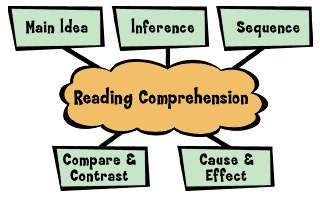Introduction
- The Reading Comprehension section in the CAT exam is crucial for evaluating a candidate's ability to understand and analyze complex passages. It goes beyond just testing reading speed and includes assessing comprehension, logical reasoning, and vocabulary.
- CAT passages cover a wide range of topics from various fields. After reading challenging passages, candidates face questions that test their understanding, inference-making, and conclusion-drawing skills.
- Mastering this section is vital as it significantly impacts the overall score and reflects real-world demands where effective comprehension and critical analysis are essential.
- CAT aspirants must develop a strategic approach and hone the necessary skills to excel in this challenging yet important part of the exam.

- The word comprehension’ actually’ means ‘grasping with intellect’ and ‘understanding.’
- Reading comprehension strategies are tools that everyone can use to help understand the meaning of what they read.
Golden Rule 1: Do Not Assume; Stick to the Passage
- One of the most crucial rules in reading comprehension is to focus strictly on the information provided within the passage.
- When answering questions, avoid using any prior knowledge or assumptions.
- Even if you know more about the topic than the passage presents, limit your understanding to what the author explicitly states or implies.
- This rule is vital because reading comprehension tests measure your ability to understand and analyze the passage itself, not your background knowledge.
- For instance, if the passage discusses environmental issues, and you know of recent data, do not bring that into your answer unless it’s mentioned.
- Remember: stick to the passage, and avoid external ideas.
[Question: 1146106]
Golden Rule 2: Start with Familiar Topics First
- When facing multiple passages, begin with ones that cover subjects you know well.
- If you’re familiar with the topic, it will likely feel easier and more enjoyable to read, giving you a confidence boost.
- For example, if you’re a commerce student, tackling passages about economic concepts might be more comfortable than passages on literature.
- By beginning with what you know, you’re setting yourself up for a smoother start, which can help boost your concentration and accuracy for the remaining passages.
- This approach works well because a confident beginning often leads to a more positive outlook on the entire reading task.
Golden Rule 3: Gain an Overview and Understand Purpose
- Before reading a passage in detail, take a moment to get a general idea of what it’s about and why it was written.
- This step helps you stay focused as you read.
- Start by skimming the first paragraph and any headings to understand the main topic and what the passage will discuss.
- It’s also helpful to think about the author’s purpose. Ask yourself: Is the author trying to inform (give facts), persuade (convince you of something), describe (paint a picture), or analyze (break down an idea)?
- Knowing this can make it easier to understand the passage. For example, if the author wants to persuade, pay attention to their arguments. If they’re informing, focus on the facts they present.
What did the author set out to achieve in writing the text?
- Were they trying to describe something?
- Were they writing an informative text?
- Were they explaining something?
- Are they writing instructions?
- Are they trying to persuade you to a point of view?

By quickly understanding the passage’s purpose and main ideas, you’ll have a roadmap for reading, making it easier to understand and remember key points.
Golden Rule 4: Identify and Mark Keywords for Better Comprehension
- As you read, make sure to highlight or write down important words. These words are small, such as if, hence, but, thus, despite, yet, and although. They act as guideposts within the text.
- Such words indicate shifts in arguments, contrasts, conclusions, or reasons. For instance, the word but often shows a contrasting point, while hence can suggest a conclusion or a result.
- By identifying these keywords, you can better follow the logical flow of the passage and predict changes in tone or reasoning.
- These keywords serve as signposts, guiding you through complex passages so you don’t get lost in the details and can focus on the main ideas.
Solving Detail-Specific Questions
- When a question asks for a specific detail in the passage, don’t try to remember where that detail was or assume it from memory.
- Instead, scan the passage for keywords from the question, which should direct you to the relevant section.
- Once you locate the part of the passage with the keywords, read the paragraph or surrounding sentences to capture the complete context.
- Often, questions that focus on details can be misleading if you read just one isolated sentence.
- By reading around the keywords, you ensure a complete understanding of the specific detail, which can prevent misinterpretations.

[Question: 1146116]
Golden Rule 5: Use Context for Vocabulary Questions
- When asked to find synonyms or antonyms of words, read the sentences before and after the word in question.
- Words can shift meaning based on their context, so relying only on your general knowledge might lead to incorrect answers.
- The surrounding lines provide the setting in which the word is used, which often clarifies its intended meaning.
- For example, if you are asked for a synonym of “bright” in a passage, it could mean intelligent or shiny depending on whether the text is discussing a person or the sun.
- The surrounding context helps you choose the most accurate answer.
Golden Rule 6: Use Targeted Strategies for Challenging Question Types
Some reading comprehension questions are more challenging and require specific techniques to answer correctly. Here’s how to approach three common tough question types:
- Main Idea Questions: For these questions, look at the beginning and ending lines of each paragraph. Authors often introduce or conclude their main points in these parts, which can reveal the passage’s central theme. Scanning these lines gives you a sense of the overall argument, which is what a main idea question typically tests.
- Choosing the Best Title: When selecting a title, avoid ones that are too narrow or overly broad. An effective title should capture the main idea without missing out on key subtopics discussed in the passage. For example, if a passage about the benefits of renewable energy sources mentions solar, wind, and hydropower, a title like “The Role of Renewable Energy” would be better than “Solar Power’s Advantages.” A title should encompass the primary theme and represent all the major points in the passage.
- Determining Tone or Mood: Tone questions require you to look for emotional cues in the text. Words with positive emotions, like encouraging, optimistic, or successful, indicate a positive tone, while words like concerned, doubtful, or pessimistic hint at a negative tone. Analyzing these tone-setting words helps you infer the author’s mood or attitude, making it easier to identify the tone accurately.
How to Crack Reading Comprehension Section
- Prepare: Getting ready in advance is key. Solve practice tests, read books, study important material, take notes, and focus on acing the CAT RC.
- Practice: Regular practice keeps your mind in the right mode. The more you practice, the easier the actual CAT reading comprehension will become. Daily activities like reading, writing, and problem-solving contribute to effective CAT RC practice.
- Patience: Take your time while reading the CAT comprehension. Rushing through it will waste time because you won't grasp anything, leading you to repeatedly return to the passage to find answers.
- Develop a Reading Habit: Make a habit of reading every day. Include light reading in your schedule, such as news or a few pages of your favourite novel. Work on improving your reading speed, and diversify your reading materials to cover various topics.

- Create Your Approach: Develop your unique approach to solving the CAT reading comprehension. Apply this approach during mock tests to be well-prepared for the actual CAT entrance exam. Having a clear plan enhances both organization and speed.
- Keyword Focus: Before diving into the CAT comprehension, glance through the questions to identify keywords. This strategy helps you understand what the questions are asking, saving time during the initial reading of the comprehension.
- Mock Test Practice: Make sure to solve numerous mock tests while preparing for CAT 2023. Regularly engaging with new CAT comprehension passages will make solving the actual CAT exam's comprehension feel like a routine task.
- Skimming Technique: Before delving into the CAT comprehension, quickly skim through the passage. Highlight important points to grasp the essence, making it easier to understand when you read it more thoroughly.
FAQs on 6 Golden Rules for reading Comprehension - CAT
| 1. What are the key strategies to improve reading comprehension for the CAT exam? |  |
Ans.The key strategies include adhering to the Golden Rules: not making assumptions and sticking to the passage, starting with familiar topics, identifying and marking keywords, using context for vocabulary questions, and employing targeted strategies for challenging question types.
| 2. How can I effectively identify keywords in a passage? |  |
Ans. You can effectively identify keywords by scanning the passage for significant terms, phrases, or concepts that are central to the main idea or specific details. Highlighting or underlining these keywords can help in quickly locating information during the questions.
| 3. Why is it important to avoid assumptions while reading comprehension passages? |  |
Ans. Avoiding assumptions is crucial because making unfounded interpretations can lead to misunderstandings of the passage's content. Sticking to the text ensures that your answers are based on evidence, which is essential for accurately responding to questions.
| 4. What should I do if I encounter challenging question types in the reading comprehension section? |  |
Ans. For challenging question types, you should utilize targeted strategies such as breaking down the question, revisiting the passage to find relevant information, and eliminating obviously incorrect options to improve your chances of selecting the correct answer.
| 5. How can context help in answering vocabulary questions in reading comprehension? |  |
Ans. Context can help by providing clues through surrounding sentences or phrases that indicate the meaning of a word. Understanding how the word is used in relation to the overall message of the passage allows for a more accurate interpretation of vocabulary questions.
Related Searches




















